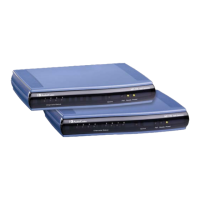MP-1xx SIP User’s Manual 8. Gateway Capabilities Description
Version 4.4 155 March 2005
• The gateway can receive and act upon receiving Refer with or without Replaces.
• The gateway can receive and act upon receiving INVITE with Replaces, in which case the
old call is replaced by the new one.
• The INVITE with Replaces can be used to implement Directed Call Pickup.
8.4.4 Call Forward
Five forms of call forward are supported:
1. Immediate - Any incoming call is forwarded immediately and unconditionally.
2. Busy - Incoming call is forwarded if the endpoint is busy.
3. No reply -The incoming call is forwarded if it isn't answered for a specified time.
4. On busy or No reply - Forward incoming calls when the port is busy or when calls are not
answered after a configurable period of time.
5. Do Not Disturb - Immediately reject incoming calls.
Three forms of forwarding parties are available:
1. Served party – the party that is configured to forward the call – MP-1xx/FXS.
2. Originating party – the party that initiated the first call – MP-1xx/FXS or FXO.
3. Diverted party – the new destination of the forwarded call – MP-1xx/FXS or FXO.
The served party (MP-1xx/FXS) can be configured through the Web browser (refer to Section
5.8.8.4 on page 96) or via ini file to activate one of the call forward modes. These modes are
configurable per gateway's endpoint.
Note the following SIP issues:
• Initiating forward – When forward is initiated, the gateway sends a 302 response with a
contact that contains the phone number from the forward table and its corresponding IP
address from the routing table (or, when Proxy is used, the proxy’s IP address).
• Receiving forward – The gateway handles 3xx responses for redirecting calls with a new
contact.
8.4.5 Call Waiting
The Call Waiting feature enables FXS gateways to accept an additional (second) call on busy
endpoints. If an incoming IP call is designated to a busy port, the called party hears call waiting
tone (several configurable short beeps) and (for Bellcore and ETSI Caller IDs) can view the Caller
ID string of the incoming call. The calling party hears a Call Waiting Ringback Tone. Called party
can accept the new call, using hook-flash, and can toggle between the two calls.
To enable Call Waiting:
• Set “EnableCallWaiting = 1”.
• Set “EnableHold = 1”.
• Define the Call Waiting indication and Call Waiting Ringback tones in the Call Progress
Tones file.
• To configure the Call Waiting indication tone cadence, modify the following parameters:
‘NumberOfWaitingIndications’, ‘WaitingBeepDuration’ and ‘TimeBetweenWaitingIndications’.
• To configure a delay interval before a Call Waiting Indication is played to the currently busy
port use the parameter ‘TimeBeforeWaitingIndication’. This enables the caller to hang up
before disturbing the called party with Call Waiting Indications. Applicable only to FXS
gateways.
Both the calling and the called sides are supported by FXS gateways; the FXO gateways support

